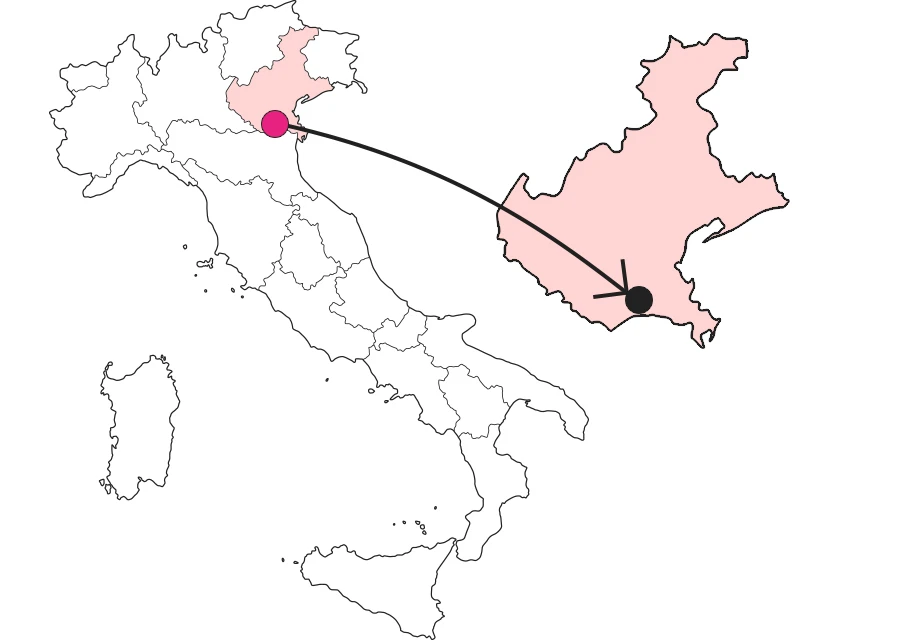SHARRYLAND


Damsel's Po: the Santa Giulia barge bridge.
The thrill of a river crossing on one of the last artifacts of a picturesque genus



Where is

What it is and where it is
The Po della Donzella is one of the seven branches of the delta formed by the great Po Valley river; after detaching from the central branch, it points southeast and reaches the Adriatic Sea after 25 kilometers of sinuous advance through the lands of the outermost reclamations of Polesine. The only chance to cross it in its lower course is offered by the Santa Giulia pontoon bridge, a structure if not quite unique, certainly rare witness to customs of times then not so distant. We speak of the interwar period, before reinforced concrete allowed the construction of spans of a width commensurate with so much river. Here, on the Po della Donzella, the roadway of the bridge rests on 22 large boats bound together and firmly anchored to the river bottom. A subject, very photogenic, not least because of the oak beams that serve as plantings. In the centerline, an unexpected accessory, a wooden capital with a crucifix. The suspicion comes, in the vague case that it was urgent to recommend the soul to God.
Why it is special
In the last postwar period, pontoon bridges, partly because they were often veterans of wartime vicissitudes, but even more because they were unsuitable for the increasing road traffic, were gradually replaced by more modern fixed structures. The survivors of their ancient lineage can be counted on the fingers of one hand, and that of Santa Giulia is among those in the most picturesque location. At this point in their history, the few pontoon bridges still in operation have become monuments unto themselves, true tourist attractions, reached to experience the thrill of the noisy passage over their wooden decking. And at their entrances signs stand out with size and speed restrictions for the vehicles that can pass over them, as if to certify the role they can play in the kind of slow tourism that is hoped for the future of the Delta.
Not to be missed
If you are not in a hurry, it is always worthwhile to have a word with the last representatives of a dying human race, the bridgesmen, i.e., those who man the bridge to take care not only of its constant maintenance, but also of its safety during, for example, river floods, when boats might be damaged by a floating log or even swept away by the current, as happened. In this case, boat decks are arranged to be opened in the middle by letting the two logs pivot by rotating until they are arranged along the bank in the position of least resistance to water. Or, conversely, in times of shoal, when the bridge may sag to the point that transit on the access ramps is problematic.
A bit of history
Until the early twentieth century crossing a large river was no triviality. More often than not, barges were deputed to this function, shuttling between the two banks. It was, of course, a paid passage, all the more so if besides people it involved dutiable goods or if the river, as in the case of the Po, marked a state border. At the busiest transit points there was convenience in setting up a pontoon bridge, a challenging operation but still better than building a masonry one. According to a multimillennial technique, this was done by placing side by side a series of barges, which were well tied together and then firmly anchored to the river bottom, so that across the hulls a wooden planking could be laid as a driveway. Even in the early twentieth century there were about twenty such pontoon bridges along the Po downstream from Pavia, to which, for a more complete picture, should also be added those that were often found at the mouths of tributaries.
Trivia
Tourist signs speak of a "barge bridge," but in truth the vessels in question are really sui generis. Yes, they have a tapered shape, to divide the current, but it doesn't really come to describe them as boats. The most surprising thing, however, is that they are concrete artifacts ! Nothing strange, because despite the high specific weight of the material, Archimedes' principle takes care of explaining how they can float. Rather, it is hard to believe that with the same technique used to build dams and chimneys one could make vessels with such thin sides. It is the chronicles of the Great War that clarify how it was precisely at that juncture that the Army Corps of Engineers specialized in the construction of boat bridges, developing a method for their mass construction thanks precisely to the use of concrete reinforced by wire mesh. And, curiosity in curiosity, once the war passed, many of those barges, now downgraded to remnants of war, but by virtue of their unyielding nature, found use in the construction of those barges that can still be found along the river today as fishing huts.
Enter the Map of Italy's Undiscovered Wonders and find treasures where you least expect it... Inspire, Recommend, Share...
Collections
The Map thanks:
Enter the Map of Italy's Undiscovered Wonders and find treasures where you least expect it... Inspire, Recommend, Share...
Where is

Collections

